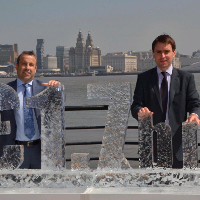Inteb is calling for a ‘C-Change’ in the attitude of British businesses towards energy saving and unveiled an ice sculpture on the shores of the River Mersey to highlight the sums that could be saved. The photo backdrop included the iconic RoyalLiverBuilding for which Inteb carries out the energy monitoring and reporting on behalf of its client RLAM.
Inteb says that the cost structure of many top British businesses is at least 16 percent too high. This is calculated on the basis of the carbon emissions they could be cutting by better managing their energy usage and the price per kWh of that unnecessary energy consumption.
The saving is calculated by using the 16 percent saving and applying it to the actual carbon usage figures that current 2011-12 CRC Energy Reduction Scheme participants have themselves reported as part of their compliance with carbon reporting legislation. The prices used in the calculation are 10p per kWh for electricity and 3.5p per kWh for gas.
Inteb stresses that a 16 percent reduction can easily be achieved by businesses in the 2011-12CRC League Table, based on the fact that clients that it has already assisted have reduced their energy costs by at least 16 percent in year one. These clients have reportedly not had to make any capital outlay and have not had to spend extra on manpower.
Most saving has been down to gaining a better understanding of when and where energy is being consumed and identifying whether energy consumption fits with the day to day operations of the business. . The 16 percent is thus a tangible and very realistic bottom-line saving that top British businesses could achieve in just one year.
If other businesses not listed in the CRC League Tables did the same, the £1.7bn monetary saving would swell significantly. This makes the £1.7bn saving the tip of the iceberg for British businesses.
Inteb is also warning that businesses only have a year in which to tackle their carbon buying effectively, as the price per tonne of carbon that is currently held at £12-£16 will be Retail Price Index-linked at the end of phase 1 of the CRC legislation. If the price of carbon rises as expected, British businesses will need to make savings to offset the price increase, just to keep their operating costs on an even keel. The danger for British business is very apparent, if businesses do nothing.
With London Stock Exchange-listed companies now having to also report on carbon emissions (since April 2013), there is more emphasis than ever on businesses needing to get their carbon usage predictions right.
At the end of phase one of the CRC programme (March 2014), businesses will have two choices when it comes to carbon buying. The first is to predict how much carbon they will use over the next 12 months and buy it in advance. The second is to wait until the end of the 12-month period and then pay for their actual carbon usage – without any knowledge of what the price per tonne may then be on the open market.
